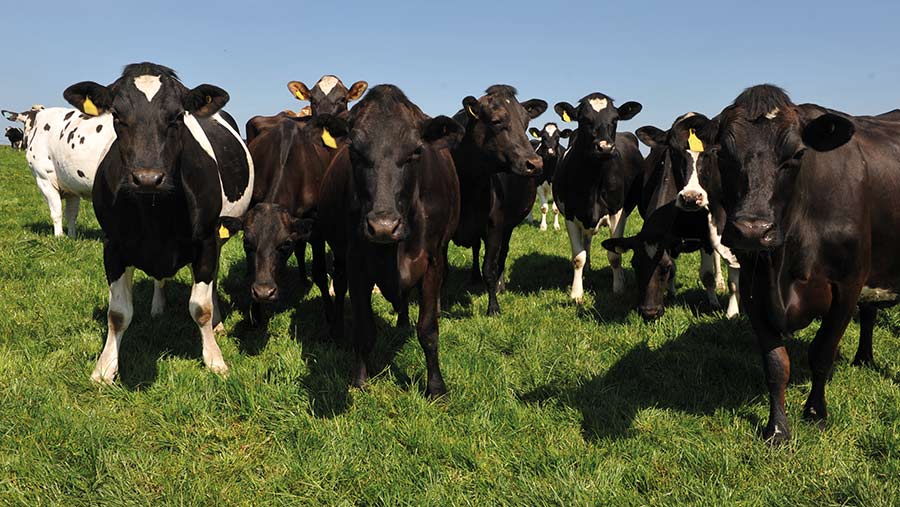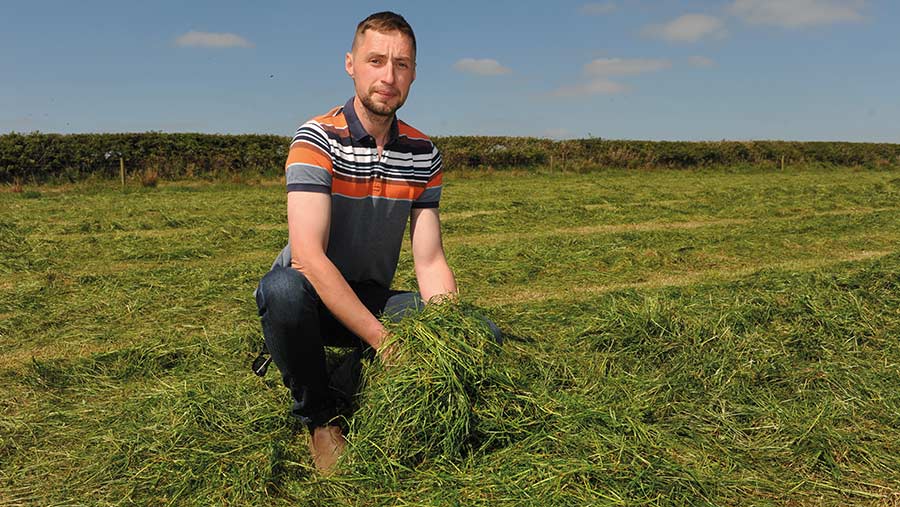How low-potassium silage has improved cow health at transition
 Iwan Francis's herd © Debbie James
Iwan Francis's herd © Debbie James Feeding low-potassium silage to autumn-calving cows during the transition period has helped a Carmarthenshire dairy farmer cut the incidence of milk fever to 5% from a peak of 20%.
Iwan Francis has spent the past two years honing transition management at Nantglas Farm, Talog, where he milks 220 cows in a split block-calving system.
He is now seeing positive results in post-calving health and performance.
At one point, 20% of the herd were getting milk fever, and at those rates there were cases of retained foetal membrane, dirty cows and poor cow transition.
With changes to feeding and management, cows and heifers now have a better start to their lactation and milk fever rates have fallen to 5%.
Farm facts – Nantglas Farm
- 130ha (321 acres) farmed
- 58ha (143-acre) grazing platform
- Three 40ha (100-acre) crops of silage cut annually; 300 big bales of silage also made
- 220 New Zealand Friesian cross-bred cows
- Autumn block calves from 20 August; spring block from 1 March
- Average annual milk yield of 6,500 litres at 4.5% butterfat and 3.5% protein
- Milk supplied to Dairy Partners
See also: How farmers and advisers are failing transition cows
This is reflected in fertility results, with 95% of the autumn block and 91% of the spring block calving in the first six weeks.
Mr Francis has introduced six new strategies for the autumn herd in the run-up to calving:
1. Feed low-potassium silage
Reducing the concentration of potassium (K) eaten by the cows before calving is a primary goal at Nantglas.
This is because incorrectly feeding dry cows has a financial cost from reduced milk yield in the subsequent lactation. It can also affect health and fertility.
Mr Francis produces low-K forage specifically for dry cows, which is cut later in the season and on land with low fertiliser inputs.
High concentrations of K in forages fed to dry cows can have a big influence on the incidence of hypocalcaemia in early-lactation cows because they make the blood more alkaline.
This negatively affects the hormonal pathway needed to mobilise calcium from the gut and bones.
That had been the position at Nantglas, with cases in the autumn-calving herd peaking at 20%.
Low-K silage is grown on 6ha (15 acres) of rented land with older permanent pasture. The grass is poorer quality compared with the other leys, and is at index 1 for phosphate (P) and K.
Mr Francis has chosen not to reseed this ley because of his requirement for low-K forage. A single application of ammonium nitrate fertiliser is spread at 34kg/ha in the spring, and no slurry is applied.
Cows graze the ley once before it is locked up for silage. It is cut at the end of June, by which time it has grown stemmy. Mr Francis likens it to standing hay.
After harvesting, the grass is tedded twice, baled and wrapped, all within 48 hours of cutting.
This forage is earmarked specifically for the autumn calvers before calving.
Vet Kate Burnby, who has been advising Mr Francis as part of his role as a Farming Connect demonstration farmer, says the aim should be for less than 1.4% K in the overall transition ration.
This means it is important to get the contribution from forage as low as possible.

Iwan Francis © Debbie James
2. Run a separate management group for transition cows
Autumn-calvers are housed three weeks before calving and fed only low-potassium forage.
High-risk cows – those that are older or overconditioned – are given a magnesium bolus at housing.
Cows that are very overweight and at risk of ketosis are also given a bolus containing the feed additive monensin.
3. Supplement magnesium
Soil testing at Nantglas has shown a calcium-to-magnesium balance of 15:1. The ideal ratio is 7:1.
To address this deficiency, 100g magnesium chloride a cow is added to the dry cows’ drinking water daily.
Housing helps to overcome the issue of cows tending to drink less water when they are at grass. As the forage is drier than grass, it encourages the cows to drink more of the magnesium-treated water.
4. Measure fatty acid levels
Blood samples are taken from transition cows to check for non-esterified fatty acids, which are present during an energy deficit. Magnesium and calcium levels are also measured.
When taking blood samples for magnesium, it is essential that cows are sampled as soon as possible after feeding, says Ms Burnby.
Magnesium is diet-dependent, so if a cow has been standing in a yard for two hours it can significantly affect the reading. Samples should be taken from a representative group and not long after feeding.
Blood sampling is often offered in packages by laboratories and typically ranges in cost from £10-£20 a cow.
5. Calve on standing hay
Second autumn-calvers and heifers calve outdoors on standing hay in a field where the grass is allowed to grow very long, to a point where it is largely stem.
This mature pasture contains a lot of long fibre to fill up the rumen.
As most of the goodness has gone from the plant, which is stalky with very little leaf, potassium content is very low.
6. Create an outdoor ‘calving pen’
A small calving paddock has been established in another field, next to the cow housing.
Each autumn-calver is turned from the shed into this paddock immediately before calving, when the water bag or the calf’s feet are visible.
Mr Francis says this provides a more hygienic environment for calving than the shed, and it is better for management, too.
“It makes it easier to check the cows and I know where the calf is,” he says.
“When I used to calve 30 or 40 cows outside in a big paddock, it could be difficult to catch the calves.”
Spring-calvers calve indoors.
Expert advice on low-K silage
Grass silage is one of the highest-risk forages in terms of potassium (K) content, with levels typically varying from 1.3% to more than 3%.
To make low-K silage, farmers should stay away from fields with a soil index of 3 or higher for K, advises silage expert Dave Davies.
Use of slurry should be avoided – the requirement is only for ammonium nitrate, he says.
“Silage fed to dry cows needs to have low digestibility, be high in fibre with a long chop and have a high dry matter content, but with a very good fermentation quality to improve palatability.
“But, most importantly, it should be low in potassium.”
Third and fourth cuts mostly have higher K levels, so avoid feeding them to dry cows, Dr Davies recommends.
Baling the silage means specific fields that have not been fertilised with K can be harvested exclusively for the dry cows.
